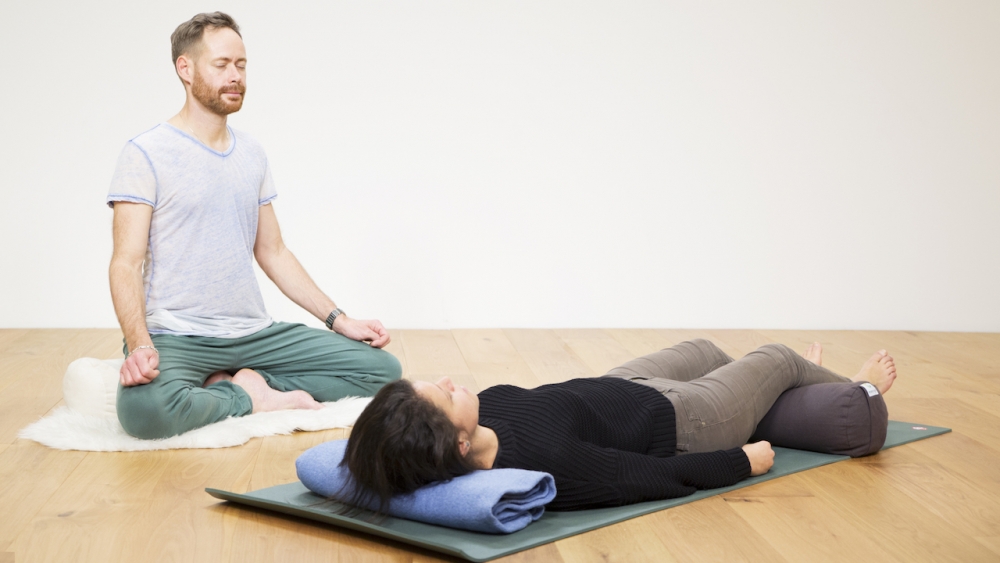
What is yoga nidra and how is it practiced?
They call it ‘yogic sleep. But, more than sleeping, Yoga Nidra is about conscious relaxation. Thanks to guided meditation, the body and mind reach a state of semi-wakefulness, highly beneficial for health.
Yoga Nidra (yogic sleep) consists of visualization and relaxation techniques that lead to an intermediate state between sleep and wakefulness.
In this relaxed state, you can remain conscious and have experiences similar to those of the REM phase (what is known as lucid dreaming).
Studies have shown that this type of yoga promotes relaxation, reduces stress, and helps in cases of insomnia and sleep disorders.
What is Yoga Nidra For Sleep
‘Yoga Nidra’ literally means ‘yogic sleep. It comes from a very old relaxation technique from India, called Nyasa.
Its practice gradually induces a deep state of relaxation and meditation, but being aware and without falling asleep. That is, it connects with the subconscious as when sleeping, but while awake.
When this semi-conscious state is reached, brain activity slows down and the body goes into a healing phase.
Anyone can practice it, although it is especially suitable for those who have sleep problems, tiredness, anxiety, and depression.
Yoga Nidra, according to The Art of Living
While Hatha Yoga relaxes the mind and invigorates the body, Yoga Nidra brings to the mind and body deeper relaxation, according to The Art of Living Foundation.
In fact, experts describe it as effortless relaxation and advise it to be practiced at the end of a sequence of yoga asanas.
In this way, after having ‘warmed up the body by doing yogic postures, Yoga Nidra cools it down. It involves the closing asana, which pays conscious attention to the different parts of the body and how they loosen and relax.
Yoga Nidra Postures
At this point we are going to explain how to practice Yoga Nidra, step by step:
Corpse pose (Shavasana). Lying on his back, he closes his eyes and relaxes. Inhale and exhale deeply and slowly.
Right side. Pay attention to the foot for a few seconds and relax it. Next, move your attention to the right knee, right thigh, and hip. Become aware of your entire right leg.
Left side. Gently repeat this process on the opposite side (left foot, knee, thigh, and hip).
Center part. Keep going over and scanning your entire body, from bottom to top. Genital area, stomach, navel region, chest.
Upper train. Pay attention to the right shoulder, right arm, palms, and fingers. Repeat this on the left shoulder, arm, throat, face, and on top of the head.
Observe. Take a deep breath and notice the sensations in your body. Relax in this state for a few minutes. Slowly becoming aware of the body.
turn around Turn to the right and lie down for a few more minutes. The breath flows through the left nostril, which helps cool the body.
Then sit up slowly and, when you feel comfortable, slowly and gradually open your eyes.
Benefits of Yoga Nidra: 30 minutes
It is one of the most popular yoga modalities since it is easy to practice and provides numerous benefits.
- Improves sleep. Half an hour of practice reduces indicators of insomnia by 33%, according to a study published in the Journal of Alternative and Complementary Medicine.
- Reduce stress. The University of Sergipe (Brazil) concluded that Yoga Nidra can be an effective tool to reduce the cognitive and physiological symptoms of anxiety.
- Increases well-being. The Kennedy Center in Denmark found an increase in dopamine tone during the shift in consciousness induced by Yoga Nidra meditation.
- Relax the muscles. The Johns Hopkins Hospital (USA) demonstrated the potential benefit of this type of yoga in reducing stress, muscle tension, and self-care.
- Deep rest. Within a few minutes, it brings a feeling similar to rest after a night’s sleep. It’s like a “super nap” that recharges in no time.
- Benefits premenstrual syndrome. King George University (India) found a significant improvement in women with menstrual irregularities, with a program of Yoga Nidra.
- Helps better control post-traumatic stress. John F. Kennedy University (USA) studied how Yoga Nidra reduced anger and anxiety and promoted relaxation and peace in military veterans.
- Helps improve back pain. The University of Bhubaneswar (India)concluded that this type of yoga has better results in the pain of lumbar spondylitis (arthritis).
- Promotes a lower blood glucose rate. Shyam Shah University (India) showed that Yoga Nidra helps control blood glucose and symptoms associated with diabetes.
- Helps calm tinnitus. Yoga Nidra improves the quality of life and helps alleviate the effects of tinnitus, a disorder in the ear in which a permanent ringing is heard.
As you can see, Yoga Nidra can help us calm our thoughts, promote sleep, and feel greater well-being. The key is to relax with awareness, remain effortless, and enter a deep state.


2 thoughts on “What is yoga nidra and how is it practiced?”